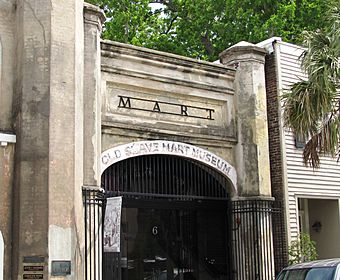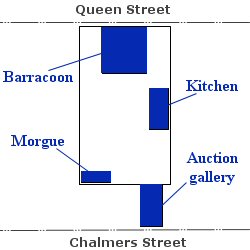Old Slave Mart facts for kids
Quick facts for kids |
|
|
Old Slave Mart
|
|

Old Slave Mart facade
|
|
| Location | 6 Chalmers Street, Charleston, South Carolina |
|---|---|
| Area | less than one acre |
| Built | 1830s <updated 7/26/21 source slave auction paper found in attic |
| Architectural style | Gothic Revival, Romanesque |
| NRHP reference No. | 75001694 |
| Added to NRHP | May 2, 1975 |
The Old Slave Mart is a historic building at 6 Chalmers Street in Charleston, South Carolina. It was once a place where enslaved people were sold during the time before the American Civil War. This building, built in 1859, is thought to be the last building of its kind still standing in South Carolina.
In 1975, the Old Slave Mart was added to the National Register of Historic Places. This means it's recognized as an important historical site because of its role in the history of African Americans in Charleston. Today, the building is home to the Old Slave Mart Museum.
The Old Slave Mart was originally part of a larger market called Ryan's Slave Mart. This market covered a big area between Chalmers and Queen Streets. Thomas Ryan, a city councilman, started this private auction place in 1856. He did this after the city made it illegal to hold slave auctions in public places. Auctions were held here until about 1863. In 1865, the Union Army took control of Charleston and closed Ryan's Mart. The Old Slave Mart Museum has been open at different times since 1938.
Building Design
The Old Slave Mart is a brick building, about 67 feet long and 19 feet wide. Its front, which faces Chalmers Street, has a smooth, plastered finish. The building was first smaller, about 44 feet long and 20 feet wide. But it was made bigger in 1922 to reach its current size.
The front of the Old Slave Mart looks special. It has tall, eight-sided pillars at each end. The main entrance is a rounded archway in the middle.
When it was first built, the building had one large room with a high ceiling, about 20 feet tall. In 1878, a second floor was added, and the roof was changed. The arched entrance originally had an iron gate. Later, in the late 1870s, simple doors were put in its place. Over the years, walls were added inside, dividing the first floor into three rooms. Today, an iron gate is back in the archway.
History of the Market
For the first half of the 1800s, enslaved people brought to Charleston were sold at public auctions. These auctions took place on the north side of the Exchange and Provost building. After Charleston banned public slave auctions in 1856, private markets were set up. These markets were enclosed and located on streets like Chalmers, State, and Queen.
One of these markets was Ryan's Mart, started by Thomas Ryan and his business partner James Marsh. Ryan's Mart first had a closed area with three buildings. These included a four-story building for holding enslaved people, a kitchen, and a "dead house."
In 1859, a person named Z. B. Oakes bought Ryan's Mart. He built the Old Slave Mart building to be an auction gallery. Inside, there was an auction table about 3 feet high and 10 feet long, just inside the arched doorway. Besides enslaved people, the market also sold land and other goods. Advertisements for slave auctions at Ryan's Mart were printed on flyers throughout the 1850s. Some of these ads even appeared as far away as Galveston, Texas.
When the U.S. Army took control of Charleston in February 1865, the people who were still enslaved at Ryan's Mart were set free.
In 1878, the Old Slave Mart building was changed into a place where people could live, with a second floor added. In the 1920s, a car dealership used the building. They added an extension to the back of the building.
Becoming a Museum
In 1938, Miriam B. Wilson bought the building and opened the Old Slave Mart Museum. At first, it showed African and African-American art. Wilson ran the museum with very little money until she passed away in 1959.
The museum closed in 1987 because of money problems. The City of Charleston and the South Carolina African American Heritage Commission worked to fix up the Old Slave Mart in the late 1990s. The museum now teaches about the history of the slave trade in the city. The area behind the building, which once held the jail and kitchen, is now a parking lot.
In 2018, the College of Charleston bought 47 boxes of documents from the museum's early years. These documents cost $5,400.
See also
- Old Charleston Jail
- Exchange and Provost
- Antebellum South Carolina
- Slave trade in the United States
- Slave markets and slave jails in the United States



